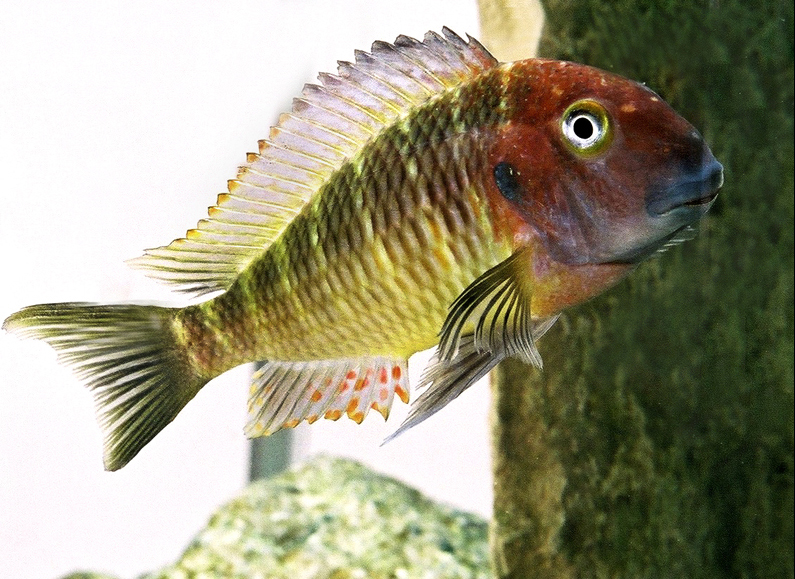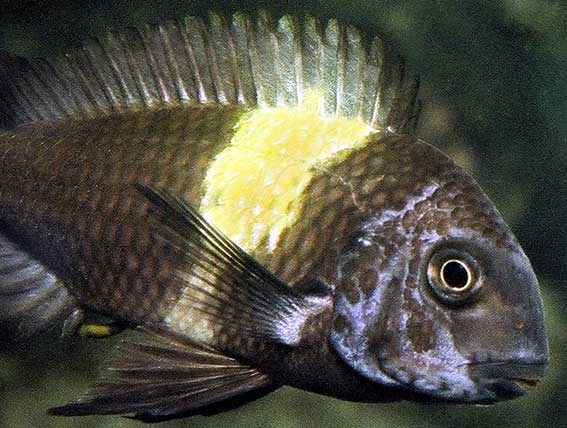Introduction
Tropheus cichlids from Lake Tanganyika are more than just fish; they’re legends in the aquarium world. With their vivid colors, unique social dynamics, and fascinating history, they’ve inspired aquarists for decades. Though often described as challenging to keep—prone to aggression, specialized diets, and health sensitivities—they hold a special place in the hearts of those who embrace their complexity.
But where did this remarkable fish come from, and how did it become the centerpiece of so many aquariums? To understand Tropheus, we must journey back to their origins in the rocky shores of Africa’s great lake and trace their path into the hobby.

Wild caught male Tropheus moori “Kala Island” Photo Fredrik Hagblom
Tropheus in the Wild: The Jewel of Lake Tanganyika
Deep in the heart of East Africa lies Lake Tanganyika, a timeless body of water that has cradled life for millions of years. Tropheus cichlids thrive along its rocky shorelines, their colors glimmering like underwater jewels. These fish are masters of survival, navigating crevices and grazing on algae in their shallow habitats.
Most Tropheus live in waters no deeper than a meter, though the enigmatic Tropheus duboisi prefers depths of up to 12 meters. For the local communities, these small yet elusive fish have been known for centuries—occasionally gracing the dinner table but never becoming a dietary staple due to their elusive nature.
The First Encounter: Tropheus moorii
The story of Tropheus began in 1895, when J.S. Moore embarked on an expedition to explore Lake Tanganyika’s aquatic treasures. Near the southern shores, he collected a striking fish with a blunt forehead and vibrant yellow spots behind its pectoral fins. These specimens, preserved and sent to George Albert Boulenger at the British Museum, became the first documented Tropheus species: Tropheus moorii.
What made this discovery groundbreaking was not just the fish’s beauty but its behavior. It was the first mouthbrooding species identified in Lake Tanganyika, challenging the assumption that all cichlids in the lake were substrate brooders. The name Tropheus, derived from the Greek word “trophos” (to foster or bring up), reflects this fascinating maternal instinct.
A Second Mystery: Tropheus annectens
In 1900, near present-day Kalemie, another type of Tropheus was collected. Initially named Tropheus annectens, it presented subtle differences from T. moorii. Boulenger hesitated, unsure if it warranted a separate classification. Decades later, in 1946, Belgian scientist Max Poll revisited the specimens and determined that T. annectens was too similar to justify its own species designation.
A Deeper Discovery: Tropheus duboisi
Nearly 60 years after the first Tropheus was described, a new chapter unfolded. In 1957, J. Dubois identified a unique Tropheus variant near Bempa village in northern Lake Tanganyika. This species, later named Tropheus duboisi, revealed striking differences:
Juveniles were adorned with fine white spots instead of vertical stripes.
Its mouth was more rounded, and lips covered the base of its teeth.
Behaviorally, it preferred solitude or small pairs, unlike the gregarious T. moorii.
Duboisi was not just a new fish but a reminder of Lake Tanganyika’s untapped mysteries.

Tropheus Duboisi “Maswa” Foto: Fredrik Hagblom
Tropheus brichardi and Tropheus polli: The Expanding Legacy
In 1975, researchers identified a new species, Tropheus brichardi, honoring cichlid importer Pierre Brichard. Two years later, Tropheus polli was discovered at Bulu Point in Tanzania, notable for its lyre-shaped tail and preference for deeper waters. These discoveries added depth—literally and figuratively—to the Tropheus family.
Modern Classification: A Growing Tree
Today, Tropheus are classified into eight groups:
Tropheus moorii
Tropheus brichardi
Tropheus duboisi
Tropheus annectens
Tropheus sp. “ikola”
Tropheus sp. “black”
Tropheus sp. “red”
Tropheus sp. “mpimbwe”
The latter four await further scientific study to determine if they merit distinct species status or fall under existing classifications.
Tropheus in the Aquarium Hobby
Tropheus first entered the aquarium trade in Germany in the 1970s, captivating fishkeepers with their bold colors and intriguing behaviors. By the mid-1980s, they had become a staple in the United States, celebrated for their unique social dynamics and visual appeal.
Though they require attentive care—including a specialized herbivorous diet and strong water circulation—the rewards of keeping Tropheus are unmatched. Their vibrant displays and complex interactions make them the stars of any aquarium.
Pro Tips for Tropheus Enthusiasts
Water Movement: Strong surface agitation is crucial for oxygenation. Invest in a high-capacity A high-capacity internal power filter is highly recommended to achieve this.
Diet: Use high-quality pellet for herbivore fish to meet their nutritional needs and prevent health issues.
Conclusion
The history of Tropheus is as rich and colorful as the fish themselves. From their discovery in Lake Tanganyika to their rise as icons in the aquarium hobby, they represent a blend of natural wonder and human fascination. By understanding their origins and meeting their care needs, fishkeepers can ensure these extraordinary cichlids continue to thrive.
